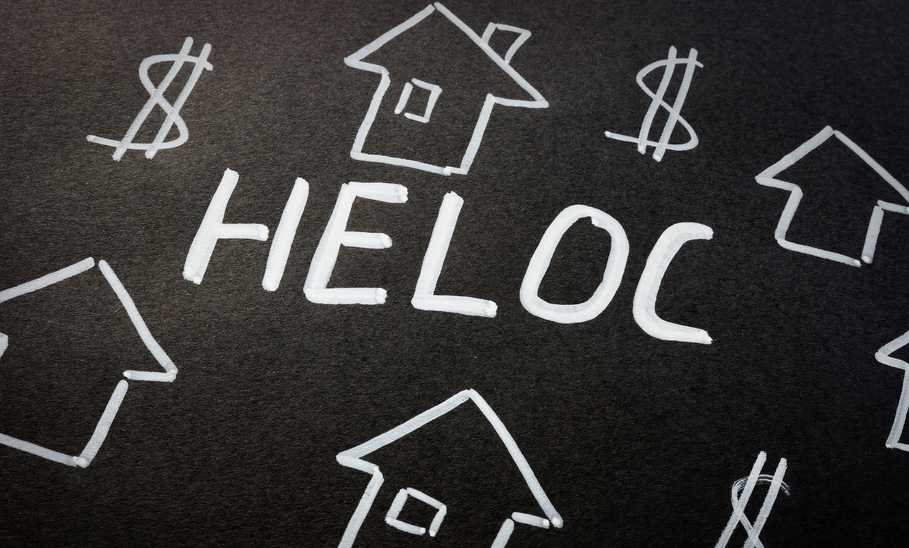What Is a Home Equity Line of Credit

Our evaluations and opinions are not influenced by our advertising relationships, but we may earn a commission from our partners’ links. This content is created by TIME Stamped, under TIME’s direction and produced in accordance with TIME’s editorial guidelines and overseen by TIME’s editorial staff. Learn more about it.
Over time, as you pay down the mortgage loan on your home and/or your property increases in value, your equity in the home increases. Equity — which is the value of that part of your home that you personally own — can then be used to secure funding in the form of a HELOC.
Here’s a look at what HELOCs are, how they work, and what to expect when trying to use your home equity to secure a loan.
The acronym HELOC stands for home equity line of credit, a type of open-ended loan that is secured by the existing equity in your home. You can pull from this line of credit as needed to cover a variety of expenses, whether you want to pay off high-interest debt, make a large purchase, or even fund home renovation projects.
Home equity is calculated by subtracting your remaining mortgage loan balance (or other liens against your property) from your home’s current market value. The maximum limit you’ll be offered on a home equity line of credit depends on certain personal factors as well as how much equity you actually have.
HELOCs are offered by a variety of financial institutions such as banks, credit unions, and mortgage lenders. Since HELOCs are a form of secured loan, you may find it easier to qualify for a larger line of credit than if you were taking out an unsecured personal loan.
Unlike a home equity loan or even a personal loan, HELOCs are revolving loans. This means that you’ll be given a total line of credit limit, which you can choose to use or not use. Similar to a credit card, you will only need to pay back what you actually withdraw from this line of credit; if you don’t ever draw from the funds, you don’t need to repay any debt.
HELOCs come with a set draw period, usually 10 years or so. During this time, you can pull from the line of credit as needed, according to the lender’s minimum draw limit and your overall line of credit limit. Depending on how your HELOC is structured, you may need to do the following:
As you repay your borrowed amount, you will also free up your line of credit further. As long as you are within the draw period, and your line of credit remains in good standing, you can continue borrowing as needed up to your credit limit.
Once you reach the end of your draw period, you will enter your HELOC’s repayment term. During this period of time, usually lasting another 15 to 20 years, you cannot draw any new funds from the HELOC. You’ll also need to make monthly payments as agreed to repay any borrowed funds up to that point.
HELOCs are secured by the equity in your home. This means that if you default on your HELOC payments, your lender can begin the process of foreclosing on your home. For this reason, a HELOC (or any other loan secured by your home) presents a bigger risk to you than an unsecured line of credit, such as a credit card.
There are many instances when taking out a HELOC can be a good idea, especially when compared to other forms of consumer borrowing. Here’s are some reasons why you would potentially want to get a HELOC:
How much you’re able to borrow with a HELOC depends on a few important variables, such as:
Generally, lenders will only allow you to open a line of credit against a portion of your available equity, usually maxing out between 75% and 85% (though this can sometimes vary).
So, let’s say you own your home outright, and the property currently appraises for $400,000. You have $400,000 in equity, but your lender has a maximum loan-to-value ratio (LTV) of 80%. In this case, you’d be limited to a line of credit maximum of $320,000, assuming you meet all other lender requirements.
Now, let’s say that you still have a $110,000 remaining mortgage balance on that property. In this case, your maximum HELOC would actually be $210,000, in order to still meet the 80% LTV requirement.
This is an example. The amount of your HELOC will depend on your credit score, income, location, and even the lender with which you choose to apply.
Though many HELOCs will have a variable interest rate, at least throughout the draw period, most will also have a rate cap. This cap is designed to limit the interest rate your borrowed amount might be subject to, ensuring that you don’t find yourself paying an unexpected and astronomical amount.
While every lender and product can be different, the interest rates on a HELOC typically follow a similar pattern.
Interest rates, represented by APR (or annual percentage rate) are often variable during the HELOC’s draw period. This means that rates can increase or decrease with market trends. This can be a good thing or a bad thing, depending on how rates are trending. (As of 2022 they have been trending up.)
Once the HELOC enters its repayment period, rates can usually be fixed through the end of the term until the balance is satisfied. This means that you’ll know exactly how much you’re paying in interest and can even predict your monthly payment requirements.
Some lenders will allow you to fix the rate of borrowed funds during the draw period, too. This most often looks like a “rate lock,” where you can fix or freeze the APR on certain withdrawals, sometimes for a specific period of time. Other lenders may allow you to choose between a fixed or variable rate during your draw period.
| Bank | Amount | Term | APR Range (or average) |
|---|---|---|---|
US Bank | $15,000 to $1 million | 10-year draw period | 7.95% to 12.55% |
BMO Harris Bank | $25,000–$150,000 | 10-year draw, 20-year repay | Starting at 5.74% |
BECU | Up to $500,000 | 25 years | Starting at 7.99% |
| Pros | Cons |
|---|---|
Interest rates can be lower than other types of consumer credit. | Your home secures the debt. |
Allows you to tap into (otherwise unused) home equity. | The process can be lengthy. |
Gives you access to a larger line of credit. | If you cancel early, penalties may be involved. |
Interest may be tax deductible. |
One of the biggest benefits of a HELOC is that the APR can be lower than other forms of revolving consumer debt, such as credit cards. If you need some time to pay off large purchases, this can save you money.
Rather than let your home equity sit unused until it’s time to sell your home, a HELOC gives you access to that value. You can then use that money to renovate your home, pay for your kids’ college tuition, take a family vacation, or simply provide you with a financial safety net.
Maximum limits on personal loans and credit cards may not be high enough if you have a large purchase to make. A HELOC, however, can give you access to a six- or even seven-figure credit limit, as long as you have the equity available in your home.
If you use the funds from a HELOC to make certain improvements on that same property, some of the interest paid may be tax deductible. This only applies if the funds are used to “buy, build, or substantially improve” the eligible property, according to the IRS.
Through 2026, these deductions (where eligible) only apply to home equity lines of credit of $750,000 or less. For taxpayers who are married but file separately, this loan limit is capped at $375,000.
If you default on unsecured credit, such as a credit card or student loan, your credit will take a hit and the bank will try to recover some of the debt however it can. If you default on a HELOC, though, you risk foreclosure on your home.
When you take out a new personal loan or open a credit card, you may have funds available to you as quickly as the same day. When it comes to borrowing against your home’s equity, though, the application, approval, and funding process can take much longer.
In most cases, your HELOC lender will want to order an updated home appraisal report to get an accurate idea of your home’s current value. This process, plus underwriting, can sometimes take weeks. So if you need cash fast, a HELOC may not be the best answer.
Many HELOC lenders will cover the closing costs involved with underwriting and issuing your line of credit. If you pay off and close out that line of credit too soon, though, you may be responsible for repaying the lender.
This is important if you plan to sell your home in the next few years. Even if you’re closing your HELOC due to a sale, many lenders will still charge you those early prepayment penalties during the first 36 months or so, which can cost you hundreds if not thousands of dollars.
Before deciding whether or not to open a HELOC, you’ll want to ask yourself a few questions.
In order to qualify for a HELOC, you’ll need to meet the lender’s eligibility requirements. These will vary from one lender to the next but usually involve the following:
You’ll need to apply in order to take out a home equity line of credit. This will typically involve you supplying the lender with certain personal information and agreeing to a credit check. If conditionally approved, the lender will often order an updated home appraisal report as well to confirm the property’s current market value.
The repayment process for a HELOC occurs in two stages.
During the draw period, or the first 10 years or so that the HELOC is open, you’ll be able to withdraw funds as needed up to your credit limit. If you don’t use any of the funds, you won’t have anything to repay. If you do borrow money, though, your lender may require you to make payments on the borrowed amount, though these are sometimes interest-only.
Once you enter the repayment period of your HELOC, you cannot make any new withdrawals without renewing the line of credit. Any remaining balance owed will go into repayment, typically at a fixed interest rate for a specific term and with a set monthly payment.
You can also choose to repay your HELOC early if you have the funds available. Just be aware that repaying and closing the line may involve penalties if it’s closed out too early.
A HELOC can be a great way to tap into unused home equity, gain access to on-demand cash, and borrow funds at a lower interest rate. However, it might not be the right answer for everyone, especially if you:
Some alternatives to HELOCs include personal loans and credit cards. Each of these give you access to funds quickly — sometimes as soon as the same or next business day — and aren’t secured by an asset such as your home.
However, both of these consumer options will limit how much you can borrow and you may find that interest rates are higher.
Both HELOCs and home equity loans allow you to borrow against your home’s current value. HELOCs, however, are an open-ended and revolving line of credit that you can tap into as needed, then repay and borrow again (similar to a credit card). Home equity loans are a single lump sum amount that is borrowed and then repaid according to a defined term and payment schedule.
A mortgage is a home loan that can be used to finance a new home purchase. This lump sum is then repaid at a fixed or variable rate for a defined period of time. A HELOC, however, is an open and revolving line of credit tied to the equity in your home (or how much of your home’s value you own). This line of credit can be pulled from as needed during the draw period and then repaid accordingly.
Personal loans are a form of unsecured debt and involve borrowing a lump sum from a lender, then repaying it back with monthly payments over a set period of time. HELOCs are open-ended lines of credit that can be borrowed against (or not) as needed.
A second mortgage is an additional loan taken out against your property’s value. They are taken out alongside an existing mortgage loan and are secured by your home. Second mortgages can include products such as HELOCs and home equity loans.
Reverse mortgages are available to homeowners age 62 or older, allowing them to access the cash equity in a home without the requirement of a monthly payment. They are repaid when the home is sold or if the owner passes away and the property is transferred to heirs.
HELOCs are available to homeowners of any age and do require a monthly payment once funds are borrowed. However, they are repaid according to a schedule.
A cash-out refinance involves taking out a new, larger mortgage loan that replaces an existing loan. The difference between the new loan and the existing loan is offered to the homeowner in the form of cash, which they can then use as they see fit.
A HELOC does not replace or even alter the existing mortgage loan. Instead, HELOCs are tied to the equity in the home and if a mortgage loan exists, the line of credit takes the position of second lien.
A HELOC is a separate product tied to the equity in your home, so taking out a HELOC does not change your existing mortgage loan or terms. Refinancing your home, on the other hand, involves replacing your mortgage with a new home loan, likely with a new interest rate, repayment term, monthly payment requirement, or other factors.
A personal line of credit and a HELOC are similar in that both give you access to on-demand cash if and when you need it. If you don’t borrow against a line of credit, you won’t need to repay anything; if you do pay back the amount borrowed, the line of credit is reinstated and funds can be borrowed again.
The difference is that a personal line of credit may be unsecured, or can be secured by an asset such as a savings account. A HELOC is exclusively secured by the equity in a qualifying home.
HELOCs aren’t repaid until funds are withdrawn. Once you draw from a HELOC, you will usually need to start making monthly payments, though these may be interest-only for the duration of the draw period. After the repayment period begins, monthly payments are fixed according to the remaining term and interest rate.
A HELOC is secured by your home’s equity. If you default on a HELOC or are unable to make payment arrangements, the lender can begin the foreclosure process on the home.
If you use the funds from a HELOC to make certain improvements on that same property, some of the interest paid may be tax deductible. This only applies if the funds are used to “buy, build, or substantially improve” the eligible property, according to the IRS.
Through 2026, these deductions (where eligible) only apply to home equity lines of credit of $750,000 or less. For taxpayers who are married by file separately, this loan limit is capped at $375,000.
The regulations surrounding mortgage interest deductions have changed in recent years and are currently scheduled to change again in the coming years. It’s always wise to speak with a tax professional if you’re not sure whether your situation qualifies.
During the draw period of a HELOC, interest rates are often variable, meaning that they can increase or decrease according to benchmark rates. There is typically a rate cap (or maximum rate that you can be charged), but rising interest rates do mean that your HELOC balance today could wind up costing you more in repayment than you expect.
Some HELOC lenders will only offer a line of credit on a primary home. However, there are lenders that will allow you to take out a HELOC on a secondary, vacation, and even investment home. Just note that your maximum LTV may be lower on an investment property than a primary one.
Because HELOCs are secured by a real estate asset (your home), they can sometimes be easier to obtain than other forms of consumer credit. You will still need to meet the lender’s credit requirements to qualify, though. If you have bad credit, you may need to apply with a co-borrower or accept a lower LTV. You may also receive a higher interest rate.
There are some lenders that offer HELOC-like products that are tied to the future equity of your home. These products, like Splitero, may cost you more in the end depending on how your home’s value trends. However, there are no credit score requirements involved.
The information presented here is created by TIME Stamped and overseen by TIME editorial staff. To learn more, see our About Us page.



